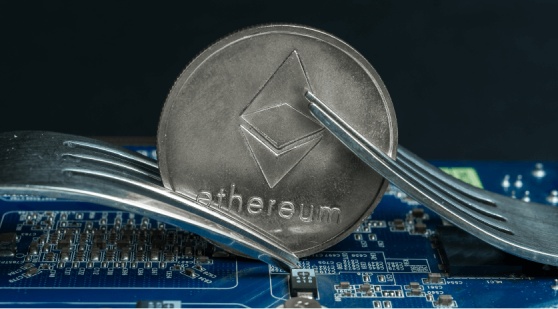-
Bitcoin was divided into two coins in the summer of 2017: bitcoin (BTC) and bitcoin cash (BCH). A hard fork is what's known as a split like that, and later that year, more forks appeared using blockchain development services.
A hard fork (or hard fork) is a major change to a network's protocol about blockchain technology that makes previously invalid blocks and transactions valid, or vice versa. After a hard fork, every node and user must update to the most recent protocol version.
Developers or members of the cryptocurrency community who are dissatisfied with the features provided by the current blockchain implementations may start forks. Hard forks could potentially become a means of crowdsourcing capital for innovative technological endeavors or cryptocurrency offerings.
Understanding Fork
When the majority of blockchain users cannot agree on an upgrade, a fork in blockchain results. A lack of agreement on divisive software updates has led to hard forks in several blockchain/cryptocurrency networks, including Bitcoin and Ethereum.
One can distinguish between accidental and purposeful forks. Accidental forks occur when two or more blocks are discovered at once. They are resolved when new blocks are added and one of the chains becomes longer than the other.
The shorter chain's blocks, also known as orphaned blocks, are then abandoned by the blockchain network. Although no transactions would be impacted because both blocks would have contained the same transactions, the miner who produced the orphaned block forfeits the mining reward and transaction fees.
Intentional forks, or the second class of blocks, come in two varieties—hard forks and soft forks—and modify the blockchain's rules.
Also, Discover | AI for DAO | Robots are Essential for a Better Future
Understanding Hard Fork
A hard fork is a rule modification that has significant effects on a blockchain network's whole protocol. A blockchain's creators or members of the community can create a fork.
All nodes intended to operate following the new rules must update their software because, in comparison to the old rules, valid blocks produced using the new rules may be viewed as invalid or invalid blocks will be viewed as valid.
Since a hard fork permanently diverges from the prior version of the blockchain, it effectively creates a brand-new currency. The new, improved blockchain will be followed by a new path and the old path by the other. The users of that specific blockchain have the option of upgrading and taking one path, or not upgrading and continuing on the other. The term "backward-incompatible" describes this.
A permanent split may happen if some users (or nodes) continue to use the outdated software while others continue to utilize the more recent version. While this occasionally happens, there are times when many nodes using the new software may decide to go back to the previous set of rules.
The most typical situation is when users of the old chain realize their version is out of date and less helpful than the new one and decide to upgrade to the new one after the new fork has been made. But the two blockchains can run parallel to each other indefinitely.
You may also like | Building Blocks to Develop a Robust Cryptocurrency Exchange
Reason to Hard Fork a Blockchain
Add New Functionality
The Blockchain code is upgraded regularly. Since the majority of public blockchains are open source, people from all over the world develop them. The improvements and issues are created, resolved and new versions must be released when the time is suitable.
Address Security Issues
Compared to traditional money (notes, coins, and checks), blockchain (and cryptocurrency on top of it) are relatively new technology. And research is currently being done to properly comprehend them. To address the security vulnerabilities that develop along the process, new versions and updates should be made available.
Also, Visit | Developing a Food Delivery App like UberEats with Blockchain
To Reverse Transactions
If the community discovers that a certain period's transactions were compromised and malevolent, it has the power to nullify them all.
Some Instances of Hard Forks
Since the launch of blockchain technology with Bitcoin in 2009, there have been several notable hard forks. As an illustration, consider Bitcoin.
In 2014, when Bitcoin XT split apart from Bitcoin, it underwent one of the first hard splits in history. A suggestion was made to enhance Bitcoin's maximum transaction rate from seven to 24 per second. To do this, each new block's size was increased from one megabyte to eight. The Bitcoin XT project, however, lost interest quickly after the fork and is no longer in use.
Following the failure of Bitcoin XT, a new proposal to increase Bitcoin's block size was made. Another hard fork occurred in 2017 and gave rise to the new cryptocurrency Bitcoin Cash (CRYPTO: BCH). A hard fork in Bitcoin Cash occurred in 2018, resulting in the creation of Bitcoin Cash ABC (the original version) and Bitcoin Cash SV (CRYPTO: BSV), a brand-new parallel network.
A few years after its birth, Ethereum likewise faced a hard fork. In response to hackers removing Ethereum from a cryptocurrency investment startup's account A fork of the DAO—"DAO" stands for "decentralized autonomous organization"—was put into place to enable those who had been attacked to retrieve part of the money from the flawed DAO.
Since Ethereum itself wasn't compromised, some miners chose not to participate.
Ethereum Classic (CRYPTO: ETC), a fork of the original blockchain, continues to exist.
Also, Check | AI and Blockchain for Technological Advancements in Healthcare
Conclusion
Hard forks are crucial for the cryptocurrency development space to develop further over time. They spread in popularity over time and make sure that the crypto industry develops following community opinion. Good coins like Litecoin or Bitcoin Cash have emerged from numerous hard forks. Therefore, in the long run, these forks are crucial for better crypto offerings. The key is to conduct research before investing.
If you are looking to hard fork a cryptocurrency/blockchain and launch a better version, you may connect with our cryptocurrency developers for assistance.

Our Offices
INDIA
Emaar Digital Greens, Sector 61,
Gurugram, Haryana
122011.
Welldone Tech Park,
Sector 48, Sohna road,
Gurugram, Haryana
122018.















